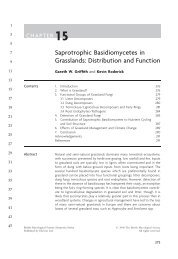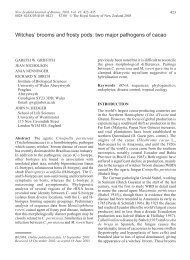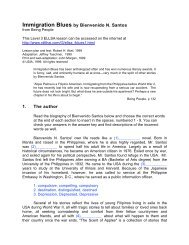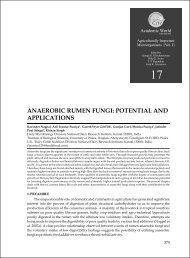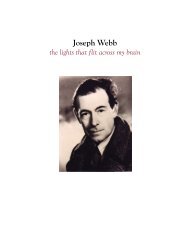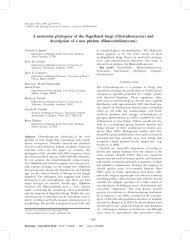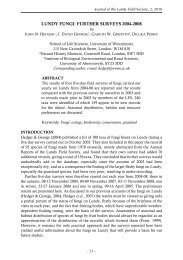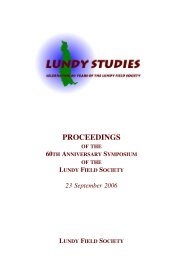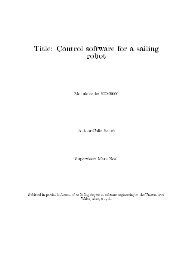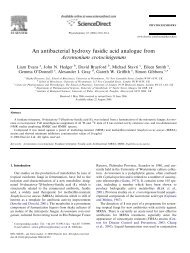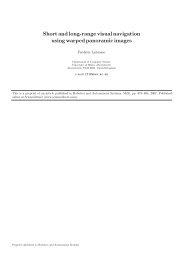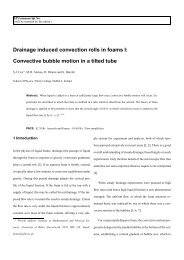Download the pdf - Users Site
Download the pdf - Users Site
Download the pdf - Users Site
You also want an ePaper? Increase the reach of your titles
YUMPU automatically turns print PDFs into web optimized ePapers that Google loves.
THE MACROFUNGI OF LUNDY<br />
by<br />
JOHN N. HEDGER, 1 J. DAVID GEORGE, 2 GARETH W. GRIFFITH 3 and LEWIS DEACON 4<br />
1 School of Biosciences, University of Westminster, 115 New Cavendish Street,<br />
London, W1M 8JS<br />
2 Natural History Museum, Cromwell Road, London, SW7 5BD<br />
3 Institute of Biological Sciences, University of Wales, Aberystwyth, SY23 3DD<br />
4 National Soil Resources Institute, School of Applied Sciences,<br />
Cranfield University, Cranfield, MK43 0AL<br />
1 Corresponding author, e-mail: hedgerj@wmin.ac.uk<br />
ABSTRACT<br />
The chapter reviews <strong>the</strong> biodiversity and ecology of fungi on Lundy island,<br />
<strong>the</strong> chief focus being on <strong>the</strong> ‘mushrooms and toadstools’ or macrofungi, but<br />
some of <strong>the</strong> microfungi, especially plant pathogens, are included. The<br />
information used in <strong>the</strong> paper is derived from records published in <strong>the</strong><br />
Annual Report of <strong>the</strong> Lundy Field Society from 1970 onwards, toge<strong>the</strong>r with<br />
<strong>the</strong> results of brief surveys carried out by <strong>the</strong> authors between 2003-06. It is<br />
concluded that, although Lundy is predictably depauperate in species of fungi<br />
associated with woodland, <strong>the</strong> high diversity of fungi characteristic of<br />
unimproved grassland and heathland indicates that Lundy may be a site of<br />
national and even international importance. Suggestions are made for fur<strong>the</strong>r<br />
work to confirm this status and for management strategies to maintain it.<br />
Keywords: Lundy, fungi, ecology, biodiversity<br />
INTRODUCTION<br />
The History of Fungi on Lundy<br />
The annual crop of edible macrofungi must have always been a welcome addition<br />
to <strong>the</strong> limited diet of <strong>the</strong> Lundy island community since its settlement by man. Some<br />
must have been put to additional uses, for example Bronze Age use as tinder for fire<br />
from some of <strong>the</strong> bracket fungi (Polyporaceae), although <strong>the</strong>re is no archaeological<br />
record to substantiate this statement. No doubt both <strong>the</strong> Marisco and Heaven families<br />
enjoyed <strong>the</strong>ir mushroom feasts in <strong>the</strong> right season during <strong>the</strong>ir suzerainties, and, in<br />
more recent history, Diana Keast (personal communication 2005) remembers with<br />
pleasure dishes of ‘field mushrooms’ (Agaricus campestris) and ‘wood blewitts’<br />
(Lepista nuda) when she lived on <strong>the</strong> island. Some of <strong>the</strong> current inhabitants still<br />
continue to enjoy this annual bounty, especially <strong>the</strong> large ‘parasol mushroom’<br />
(Macrolepiota procera) (Plate 1).<br />
- 139 -
Plate 1: Macrolepiota procera (parasol mushroom)<br />
with <strong>the</strong> Old Light in <strong>the</strong> background.<br />
October 2003. (Photo: John Hedger)<br />
- 140 -<br />
More formal records of<br />
fungi on Lundy only began<br />
with reports of sightings,<br />
usually of <strong>the</strong> macrofungi by<br />
interested visiting members of<br />
<strong>the</strong> Lundy Field Society and<br />
<strong>the</strong>se have appeared at irregular<br />
intervals in <strong>the</strong> Annual Reports<br />
of <strong>the</strong> Lundy Field Society.<br />
The accumulated list for <strong>the</strong><br />
period 1970-1995, abstracted<br />
from <strong>the</strong> Annual Reports, was<br />
summarised in Hedger &<br />
George (2004) and stood at<br />
some ninety-five species, to<br />
which <strong>the</strong>y were able to make<br />
seventy-five additions from a<br />
week long survey in October<br />
2003. Since <strong>the</strong>n we have<br />
carried out fur<strong>the</strong>r short<br />
surveys, in November 2004,<br />
April 2005 and January 2006<br />
(Hedger, George, Griffith &<br />
Deacon unpublished data). In<br />
<strong>the</strong>se surveys <strong>the</strong> field of<br />
search was extended to <strong>the</strong> microfungi on living plants, dead wood and plant litter,<br />
and 188 additional records were made, bringing <strong>the</strong> total to 358 species. It is planned<br />
to continue to publish <strong>the</strong>se data in <strong>the</strong> Annual Reports.<br />
The object of <strong>the</strong>se studies was to start a more systematic inventory of <strong>the</strong> diversity<br />
of fungi on Lundy, and <strong>the</strong> habitats <strong>the</strong>y occupy on <strong>the</strong> island, and to begin a database<br />
of Lundy fungi for entry in <strong>the</strong> British Mycological Society U.K. recording scheme. As<br />
with most mycological surveys, we have used <strong>the</strong> identification of fruit bodies of <strong>the</strong><br />
fungi to establish <strong>the</strong> records, a practical approach, which can also be used to study <strong>the</strong><br />
ecology of different species, but with some reservations, because <strong>the</strong> active mycelium<br />
remains hidden in <strong>the</strong> soil, wood or litter. Ecological surveying in this way is<br />
equivalent to using <strong>the</strong> flowers to map plant distribution, and has its predictable defects,<br />
especially in studies of <strong>the</strong> larger fungi. In some years fungi may not fruit, in o<strong>the</strong>rs be<br />
abundant, which, combined with <strong>the</strong> shortness of study visits to <strong>the</strong> island, means that<br />
<strong>the</strong>re is a high degree of serendipity to <strong>the</strong> process. In addition, <strong>the</strong> many microfungi<br />
are much more diffÆult to survey in this way, although determination of <strong>the</strong>ir fruiting<br />
structures with hand lens and microscope on particular plants or litter indicates <strong>the</strong>ir<br />
ecological preferences. However, despite <strong>the</strong>se problems, even brief surveys can give<br />
useful information on <strong>the</strong> ecology of fungi on Lundy, especially <strong>the</strong>ir association with<br />
particular habitats and plants, and this is explored in more detail in this review.
The Lundy Climate and Fungi<br />
There have been very few mycological studies of isolated British islands such as<br />
Lundy, one exception being <strong>the</strong> Hebrides from which Dennis (1986) recorded 2,905<br />
species, although <strong>the</strong>se have a much greater land area, and a different climate and soil<br />
to Lundy. Better parallels are, perhaps, <strong>the</strong> nearby Welsh islands of Skomer and<br />
Skokholm, but <strong>the</strong>se are also little known mycologically. As with o<strong>the</strong>r aspects of<br />
island biology, <strong>the</strong>re are intriguing contrasts to <strong>the</strong> mainland. The ameliorating<br />
influence of a maritime climate makes winter frost a comparative rarity, so that <strong>the</strong><br />
macrofungi of autumn may continue to fruit for far longer on Lundy than <strong>the</strong> mainland,<br />
and on our visit in January 2006 we found quite a number of autumnal grassland<br />
species, long gone from <strong>the</strong> pastures of Devon. On <strong>the</strong> o<strong>the</strong>r hand, <strong>the</strong> strong winds on<br />
Lundy, <strong>the</strong> lack of shelter, and <strong>the</strong> thin granitic soils, may create very dry conditions<br />
in summer and early autumn, which reduce <strong>the</strong> fruiting of <strong>the</strong> fungi. Visits in<br />
September and October to search for macrofungi may be disappointing when compared<br />
to <strong>the</strong> mainland (Hedger & George, 2004). Our own experience indicates that early<br />
November is likely to be <strong>the</strong> best season, when soil temperatures remain warm, but<br />
moisture content has risen. However a wet summer would completely alter this picture.<br />
The Roles of Fungi in <strong>the</strong> Terrestrial Ecosystem on Lundy<br />
Fungi play a key role in <strong>the</strong> terrestrial food web on Lundy, as in all terrestrial<br />
ecosystems. One functional grouping, decomposer or saprotrophic fungi, are of great<br />
importance in <strong>the</strong> recycling of nutrients. They do so using enzymes which break<br />
down <strong>the</strong> components of plant litter and wood, eventually releasing CO 2, water and<br />
minerals. Their hyphae are in turn grazed by soil-, wood- and litter-inhabiting<br />
animals (detritivores), such as worms, thrips, mites and millipedes, which in turn<br />
form part of a food web which ends with <strong>the</strong> larger animals on Lundy, such as <strong>the</strong><br />
pygmy shrew and many species of bird. On Lundy <strong>the</strong> most obvious decomposer<br />
species are many of <strong>the</strong> macrofungi, basidiomycetes and ascomycetes, both in <strong>the</strong><br />
wooded areas and in different types of grassland and heath, but <strong>the</strong>re are also many<br />
microfungi, some highly specific to litters of particular plant species, o<strong>the</strong>rs much<br />
more widespread.<br />
A second functional grouping is <strong>the</strong> many species of fungi which form<br />
mutualistic relationships with <strong>the</strong> roots of plants, termed mycorrhizas, and whose<br />
hyphae assist plants by uptake of key nutrients from <strong>the</strong> soil and litter, thus<br />
completing <strong>the</strong> recycling of minerals. On Lundy most of <strong>the</strong>se ‘helper’ fungi are<br />
likely to be microfungi, forming single spores in <strong>the</strong> soil, and which infect <strong>the</strong> roots<br />
of herbaceous plants and grasses as Arbuscular Mycorrhizas (AM), although as yet<br />
no investigation has been made to prove <strong>the</strong>ir presence. Most belong to <strong>the</strong> family<br />
Engonaceae and a few, in <strong>the</strong> genus Endogone, form tiny, but visible, truffle-like<br />
fruit bodies, one of which was found in <strong>the</strong> 2003 survey in a rush clump (Hedger &<br />
George, 2004). A number of <strong>the</strong> trees on Lundy, including <strong>the</strong> sycamores (Acer<br />
pseudoplatanus) and ashes (Fraxinus excelsior) in Millcombe valley have similar<br />
AM partners to <strong>the</strong> grasses. However some of <strong>the</strong> o<strong>the</strong>r tree species on Lundy, for<br />
example all <strong>the</strong> species of oaks and pines, form associations called Sheathing or<br />
-141-
Ectomycorrhizas with macrofungi (ascomycetes and basidiomycetes). These are<br />
sometimes specific to tree species, and are signalled by <strong>the</strong> presence of fruit bodies<br />
of <strong>the</strong> partner fungi under <strong>the</strong> tree in <strong>the</strong> autumn. These are produced by a mycelium<br />
which ramifies through <strong>the</strong> soil and litter, but which also envelopes part of <strong>the</strong> root<br />
system in a mycelial sheath, through which nutrient exchange takes place, <strong>the</strong>reby<br />
assisting <strong>the</strong> host tree.<br />
A third functional grouping is <strong>the</strong> pathogenic fungi which invade living plants<br />
and trees on Lundy. The effects of <strong>the</strong>se pathogens range from killing parts of <strong>the</strong><br />
plant, to almost symptomless infections. Fungi which invade <strong>the</strong> plant and kill <strong>the</strong><br />
tissue are often called ‘necrotrophs’ (lit. ‘feeding off death’) and <strong>the</strong>ir presence on<br />
plants is shown by brown areas of dead tissue on leaves and stems. The effects are<br />
often only local - for example, just a few brown spots on <strong>the</strong> leaves. On Lundy most<br />
of <strong>the</strong>se necrotrophs are microfungi, some of which are specific to particular plant<br />
species, o<strong>the</strong>rs have a wide host range. In contrast <strong>the</strong> fungal pathogens called<br />
‘biotrophs’(lit. ‘feeding off life’) infect <strong>the</strong> host with few or no symptoms. Infected<br />
plants may appear completely healthy, although <strong>the</strong>re is sometimes some<br />
malformation of tissues. The production of spores by <strong>the</strong> fungus, for example in<br />
pustules on a leaf surface, may be <strong>the</strong> only sign that <strong>the</strong> plant is infected. These<br />
fungi have a very narrow host range, sometimes just one plant species. All are<br />
microfungi and on Lundy include <strong>the</strong> rusts (Uredinales), <strong>the</strong> smuts (Ustilaginales),<br />
<strong>the</strong> powdery mildews (Erysiphales) and <strong>the</strong> downy mildews (Peronosporales).<br />
WOODLAND HABITATS FOR FUNGI ON LUNDY<br />
The past land-use on Lundy, as with o<strong>the</strong>r small islands, has had a disproportionate<br />
influence on <strong>the</strong> vegetation and its associated fungi compared to <strong>the</strong> mainland.<br />
Clearance of such postglacial forest cover as existed on Lundy probably began in <strong>the</strong><br />
Bronze Age and Hubbard (1971) considers that cutting of trees for construction and<br />
firewood by islanders and visiting ships, combined with <strong>the</strong> exposure, meant that <strong>the</strong><br />
island was almost completely treeless as far back as <strong>the</strong> thirteenth century, although<br />
she cites evidence that scrub, such as gorse, willow and blackthorn, must have<br />
persisted. Large scale replanting of trees only began in <strong>the</strong> nineteenth century, many<br />
of <strong>the</strong>m exotic species such as turkey oak, holm oak and Corsican pine, possibly<br />
accompanied by associated fungal species. The surviving tree cover is now restricted<br />
to <strong>the</strong> S.E. end of <strong>the</strong> island, especially <strong>the</strong> Millcombe Valley area (South Wood,<br />
North Wood, St John’s Copse and Lower Millcombe), <strong>the</strong> small pockets of planted<br />
alders, sycamores, pines and oaks fur<strong>the</strong>r up <strong>the</strong> east coast, including St Helen’s<br />
Copse and Quarter Wall Copse, and <strong>the</strong> few scattered willows around <strong>the</strong> Quarry.<br />
As well as such ‘true’ woodland, <strong>the</strong> extensive gorse/blackthorn scrub behind<br />
Brambles Cottage and around <strong>the</strong> Flagstaff and <strong>the</strong> Ugly, as well as <strong>the</strong><br />
rhododendron along <strong>the</strong> east coast path, also represent a type of woodland habitat<br />
(Dawkins 1974 in Hubbard 1997).<br />
It has been estimated that about 80% of <strong>the</strong> macrofungi of <strong>the</strong> Ne<strong>the</strong>rlands are<br />
associated with trees (Arnolds & De Vries 1989 in Griffith et al., 2004), and <strong>the</strong><br />
U.K. figure is probably similar. Most of <strong>the</strong> decomposer and mycorrhizal fungi<br />
- 142 -
associated with <strong>the</strong> original forest cover on Lundy must have been lost, although<br />
Hedger & George (2004) have speculated that some of <strong>the</strong> wood decomposer species<br />
which <strong>the</strong>y recorded fruiting on gorse and blackthorn on Lundy today, may represent<br />
persistence. O<strong>the</strong>r species may have been introduced on <strong>the</strong> roots of <strong>the</strong> replanted trees<br />
or arrived as spores from <strong>the</strong> mainland. Of <strong>the</strong> 358 species of fungi at present recorded<br />
for Lundy only 65 were associated with trees, of which twelve were mycorrhizal<br />
species, <strong>the</strong> o<strong>the</strong>r 53 were wood and woodland litter decomposer species.<br />
Wood Decomposer Fungi<br />
The majority of <strong>the</strong> 53 species of decomposer fungi so far recorded in wooded areas<br />
were found fruiting on dead trees or fallen branches (wood decomposers), <strong>the</strong> rest<br />
were recorded from leaf litter or small twigs under <strong>the</strong> trees (litter decomposers).<br />
Commonest were <strong>the</strong> basidiomycete fungi popularly known as bracket fungi or<br />
polypores, but <strong>the</strong>re were also species of o<strong>the</strong>r basidiomycetes, <strong>the</strong> agarics or gill<br />
fungi, and also of <strong>the</strong> sac or flask fungi, ascomycetes which also fruit on wood.<br />
Primary attack on wood by fungi usually results in ei<strong>the</strong>r bleaching (white rot<br />
decay) or <strong>the</strong> wood becomes brown and powdery (brown rot). The majority of wood<br />
decay on Lundy is by white rot fungi and <strong>the</strong> commonest species is undoubtedly <strong>the</strong><br />
basidiomycete Schizopora paradoxa, (Plate 2) which can be found as a white crust<br />
with a surface of beautiful too<strong>the</strong>d pores, on rotting branches of nearly all tree and<br />
shrub species, even including rhododendron. Some o<strong>the</strong>r white rot basidiomycetes<br />
such as <strong>the</strong> ‘zoned polypore’, Trametes versicolor, also have a wide host range. In<br />
contrast o<strong>the</strong>r species have a narrow host range, for example, <strong>the</strong> aptly named<br />
‘blushing bracket’, Daedaleopsis confragosa, found only on willows (Salix spp.), for<br />
example in <strong>the</strong> Quarries; <strong>the</strong> glistening white mushrooms of ‘beech tuft’ or ‘porcelain<br />
fungus’, Oudemansiella mucida, only on branches of <strong>the</strong> solitary beech (Fagus<br />
sylvatica) at Quarter Wall Copse; and <strong>the</strong> white crust-like Lyomyces sambuci (Plate 3)<br />
only on dead elder, Sambucus niger,especiallyin<strong>the</strong>WalledGardenatMillcombe.As<br />
already noted, Hedger & George (2004) speculated that <strong>the</strong> host preferences of many<br />
wood rot fungi on Lundy were different to <strong>the</strong> reports of ‘normal’ hosts in <strong>the</strong> literature,<br />
perhaps due to lack of <strong>the</strong> trees. One examples is Phellinus tuberculosus, (Plate4)<br />
whose large hoof-shaped woody fruit bodies are normally found on Prunus and o<strong>the</strong>r<br />
rosaceous trees, but is often found fruiting on wood of dead gorse, Ulex europaea, on<br />
Lundy. Ano<strong>the</strong>r is <strong>the</strong> ‘beef steak mushroom’ Fistulina hepatica, normallyonoak,but<br />
found on sweet chestnut in <strong>the</strong> Millcombe Valley.<br />
The ascomycete fungi involved in primary white rot attack on wood on Lundy<br />
include a number with hard black fruiting bodies - often called pyenomycetes. ‘King<br />
Alfred’s cakes’, Daldinea concentrica (Plate 5), whose black fruit bodies are restricted<br />
to <strong>the</strong> ash trees (Fraxinus excelsior) in Millcombe valley, is a good example. O<strong>the</strong>rs<br />
include species of Hypoxylon, withgroupsofsmallhardroundedfruitbodies,for<br />
example H. multiforme on rhododendron wood, and species of Xylaria, wi<strong>the</strong>longated<br />
black fruit bodies, such as <strong>the</strong> finger-shaped X. polymorpha,restrictedtodeadsycamore<br />
branches in Millcombe valley. O<strong>the</strong>r ascomycete decay fungi appear on <strong>the</strong> underside<br />
of well-rotted branches and logs as small disc-shaped fleshy fruit bodies or<br />
- 143 -
Plate 3: Lyomyces<br />
sambuci on dead<br />
elder in <strong>the</strong> Walled<br />
Garden, Millcombe<br />
Valley. April 2005.<br />
(Photo: David<br />
George)<br />
- 144 -<br />
Plate 2:<br />
Shizophora<br />
paradoxa. Detail<br />
of fruit body<br />
on <strong>the</strong> underside<br />
of dead<br />
rhododendron<br />
log, east coast<br />
path. April 2005.<br />
(Photo: David<br />
George)<br />
Plate 4: Phellinus<br />
tuberculosus on dead<br />
gorse, behind<br />
Brambles. October<br />
2003. (Photo: John<br />
Hedger)
Plate 5: Daldine<br />
concentrica (King<br />
Alfred’s cakes) on<br />
dead ash in<br />
Millcombe Valley.<br />
April 2005. (Photo:<br />
David George)<br />
Plate 7: Hypholoma<br />
fasciculare (sulphur<br />
tuft) on dead<br />
rhododendron near<br />
The Ugly. October<br />
2003. (Photo: John<br />
Hedger)<br />
- 145 -<br />
Plate 6: Mollisia<br />
cinerea on dead<br />
willow in <strong>the</strong><br />
Quarries. April 2005.<br />
(Photo: David<br />
George)
apo<strong>the</strong>cia (discomycetes). Unlike <strong>the</strong> pyenomycetes <strong>the</strong>y do not seem to be usually<br />
primary decomposers, but colonise wood in an advanced state of decay. The<br />
commonest are grey apo<strong>the</strong>cia produced by Mollisia species (Plate 6). These may<br />
occur alongside <strong>the</strong> attractive bright yellow apo<strong>the</strong>cia of Bisporella citrina.<br />
O<strong>the</strong>rs of <strong>the</strong>se minute discomycetes occur on specific hosts, for example troops<br />
of <strong>the</strong> beautiful, but minute, white discs of Hyaloscypha stevensonii are only found<br />
on undersides of well-decayed fallen branches of Corsican pines, Pinus nigra var.<br />
maritima, in <strong>the</strong> Millcombe Valley. Alongside <strong>the</strong>se discomycetes on <strong>the</strong> well-rotted<br />
pine wood can be found ano<strong>the</strong>r group of organisms, <strong>the</strong> myxomycetes, or slime<br />
moulds, which although protistans, and not true fungi, produce minute fungal-like<br />
fruiting bodies. Their plasmodia feed on <strong>the</strong> previous fungal and bacterial colonisers<br />
in <strong>the</strong> wood prior to fruiting. Species found to date include <strong>the</strong> pink Arcyria denudata,<br />
<strong>the</strong> intriguingly basket-shaped Comatricha nigra and <strong>the</strong> yellow pin-headed Trichia<br />
varia. On <strong>the</strong> drier upper surface of <strong>the</strong> pine logs, <strong>the</strong> confusingly similar, yellow,<br />
button-shaped, minute gelatinous fruit bodies of Dacrymyces stillatus may be found.<br />
This is actually a basidiomycete fungus. The fruit bodies are very tolerant of drying<br />
and <strong>the</strong> species is also a successful coloniser of <strong>the</strong> tops of fence posts and gates all<br />
over <strong>the</strong> island. It is closely related to <strong>the</strong> ‘jelly fungus’, Tremella mesenterica,<br />
whose orange gelatinous fruit bodies occur on dead wood of gorse, and to <strong>the</strong> ‘ear<br />
fungus’, Auricularia auricula-judae which colonises dead elder and is common in <strong>the</strong><br />
Walled Garden in Millcombe Valley. Interestingly <strong>the</strong>se three gelatinous species are<br />
amongst <strong>the</strong> earliest records of fungi from Lundy (Walker & Langham, 1971),<br />
probably because of <strong>the</strong> durability of <strong>the</strong>ir fruit bodies and lack of seasonality.<br />
There are fewer fungi on Lundy which cause brown rot decay of wood, <strong>the</strong> most<br />
common being <strong>the</strong> yellow to orange-brown, crust-like fruit bodies of <strong>the</strong> ‘polypore’<br />
Coniophora puteana and <strong>the</strong> related species, C. arida, which are very abundant on<br />
<strong>the</strong> many dead treated stumps of rhododendron by <strong>the</strong> side of <strong>the</strong> coastal path in <strong>the</strong><br />
east side clearance areas, and which are slowly reducing <strong>the</strong>se stumps to brown<br />
powder. Normally <strong>the</strong>se species are recorded from conifer wood. Interestingly, many<br />
rhododendron stumps are also colonised by white rot fungi. These include <strong>the</strong><br />
‘sulphur tuft’ agaric, (Hypholoma fasciculare) (Plate 7) which forms clumps of<br />
sulphur yellow toadstools. Where <strong>the</strong> species occur toge<strong>the</strong>r, contrasting brown and<br />
white rot can be seen in <strong>the</strong> same stump. In passing it should be noted that <strong>the</strong><br />
bonfires in this area have stimulated <strong>the</strong> autumn fruiting of troops of a small browncapped<br />
agaric, Pholiota carbonaria, which is restricted to burnt ground.<br />
Mycorrhizal Fungi and Woodland Litter Decomposer Fungi<br />
Under <strong>the</strong> trees, <strong>the</strong> fungi that are found fruiting on <strong>the</strong> soil or litter are ei<strong>the</strong>r<br />
mycorrhizal, associated with <strong>the</strong> roots of <strong>the</strong> trees, or are decomposer fungi, breaking<br />
down <strong>the</strong> leaf and twig litter. The mycorrhizal species recorded to date are large and<br />
obvious late summer/autumn macrofungi, including agarics and boletes in <strong>the</strong> genera<br />
Lactarius, Russula, Cortinarius, and Boletus and <strong>the</strong> ‘earth ball’ (Scleroderma<br />
citrinum). They represent some of <strong>the</strong> earliest observations of fungi on Lundy in <strong>the</strong><br />
early 1970s (Walker & Langham, 1971; Walker, 1972). Examples found in our 2003<br />
- 146 -
survey (Hedger & George, 2004) included <strong>the</strong> dull yellow agaric Russula ochroleuca<br />
under <strong>the</strong> holm oaks in St John’s Copse, and <strong>the</strong> brighter purple R. krombholtzii<br />
(=R.atropurpurea) under <strong>the</strong> beech in Quarter Wall Copse growing alongside <strong>the</strong><br />
yellow-pored bolete Xerocomus (=Boletus) spadiceus. Our own records and past<br />
records combine to give a total of some twelve species of mycorrhizal macrofungi,<br />
a strikingly small total compared to a mainland woodland. Perhaps Lundy is truly<br />
depauperate in mycorrhizal fungi, but more must be present but not yet recorded. For<br />
example Amanita muscaria, <strong>the</strong> ‘fly agaric’, a large fungus with bright red cap with<br />
white spots, would be expected in association with <strong>the</strong> planted species of pine (Pinus<br />
radiata, P. nigra var. maritima and P. sylvestris), as would <strong>the</strong> large bolete Suillus<br />
luteus, ‘slippery jack’, and yet nei<strong>the</strong>r have been recorded. This may be true of o<strong>the</strong>r<br />
almost universally common mycorrhizal species in <strong>the</strong> U.K., such as <strong>the</strong> orange<br />
brown agaric Laccaria laccata, ‘<strong>the</strong> deceiver’ and <strong>the</strong> related purple L. amethystina,<br />
‘<strong>the</strong> purple deceiver’, both yet to be found on Lundy.<br />
The litter under <strong>the</strong> trees is broken down by decomposer species of fungi. As<br />
<strong>the</strong>ir mycelium spreads through <strong>the</strong> litter it is often bleached by <strong>the</strong>ir action. As with<br />
<strong>the</strong> mycorrhizal fungi, some are associated with particular tree species, and may also<br />
be at least in part mycorrhizal. The best example is <strong>the</strong> small brown agaric Alnicola<br />
suavis, appropriately found growing on <strong>the</strong> leaf litter under <strong>the</strong> alders in St Helen’s<br />
Copse, but also with <strong>the</strong> willows at <strong>the</strong> Quarry (Hedger & George, 2004). O<strong>the</strong>r<br />
species of decomposers are more widespread and include a number of species of<br />
delicate, often small, white-gilled agarics in <strong>the</strong> genus Mycena, (Plate 8) and medium<br />
sized species of Collybia, also with white gills, but with flat white to brown caps and<br />
tough bendable stems, such as <strong>the</strong> dry-capped C. dryophila, also found decomposing<br />
bracken litter all over Lundy, and <strong>the</strong> ‘buttery agaric’, C. butyracea, a greasy-capped,<br />
late autumn species preferring acid litter, and found fruiting under <strong>the</strong> pines and<br />
gorse in Millcombe Valley. The larger woodland litter decomposer agarics include<br />
<strong>the</strong> ‘shaggy parasol<br />
mushroom’, Macrolepiota<br />
rhacodes, found in<br />
November 2003 fruiting in<br />
<strong>the</strong> nettles by <strong>the</strong> Castle<br />
(Hedger & George, 2004),<br />
but probably also present in<br />
<strong>the</strong> Millcombe Valley. This<br />
is similar to <strong>the</strong> ‘parasol<br />
mushroom’, M. procera,<br />
widespread in autumn in<br />
<strong>the</strong> grassland around <strong>the</strong><br />
Old Light, but differs in<br />
having a scaly stem and in<br />
slow reddening of <strong>the</strong> flesh<br />
of <strong>the</strong> stem when bruised<br />
or cut.<br />
Plate 8: Mycena filopes under willow in <strong>the</strong> Quarries.<br />
October 2003. (Photo: John Hedger)<br />
- 147 -
GRASSLAND AND HEATH HABITATS FOR FUNGI ON LUNDY<br />
Grassland and Heath vegetation covers most of Lundy and is <strong>the</strong> major terrestrial<br />
habitat. It is not however uniform. Hubbard (1997) divided <strong>the</strong> non-woody vegetation<br />
on Lundy into two categories: <strong>the</strong> Sidelands and <strong>the</strong> Plateau, and <strong>the</strong> same approach<br />
is followed here.<br />
The Sidelands<br />
Of <strong>the</strong> Sidelands, <strong>the</strong> east coast has <strong>the</strong> most species-diverse plant communities,<br />
especially on <strong>the</strong> shale slopes of <strong>the</strong> sou<strong>the</strong>rn end, where <strong>the</strong> Lundy cabbage,<br />
Coincya wrightii has its stronghold. Moving fur<strong>the</strong>r north along <strong>the</strong> east coast path<br />
into <strong>the</strong> granite geology, <strong>the</strong> dominance of rhododendron and <strong>the</strong>n bracken reduces<br />
<strong>the</strong> diversity of plants and associated fungi, although <strong>the</strong>re are a number of very<br />
interesting fungi in <strong>the</strong>se localities associated with <strong>the</strong> plant cover, for example hostspecific<br />
fungi on <strong>the</strong> rhododendrons, such as ‘purple leaf spot’ Cercoseptoria<br />
handelii and <strong>the</strong> aptly named ‘bud blast’, Pycnostysanus azaleae, which can be<br />
detected by its tiny pin-shaped spore structures on dead blackened flower buds. In<br />
contrast, <strong>the</strong> west and north coast Sidelands are much more exposed and botanically<br />
poorer, being dominated by just a few species, especially sea fescue (Festuca rubra)<br />
and sea pink (Armeria maritima), so it is also likely to have fewer species of fungi.<br />
Most of <strong>the</strong> species of macrofungi found on <strong>the</strong> granitic areas of <strong>the</strong> East<br />
Sidelands are also found on <strong>the</strong> Plateau, for example those associated with bracken,<br />
which dominates sideland areas such as Brazen Ward. These are mostly decomposer<br />
agarics growing as mycelia in <strong>the</strong> deep bracken litter, such as <strong>the</strong> bright orange<br />
Hygrophoropsis aurantiacus, ‘<strong>the</strong> false chanterelle’, (Plate 9) and grey-white species<br />
of Collybia and Clitocybe, <strong>the</strong> latter genus including <strong>the</strong> large, stoutly-stemmed,<br />
C. nebularis, ‘<strong>the</strong> clouded clitocybe’, which forms fruit body rings 2-3 m in diameter<br />
in <strong>the</strong> autumn in <strong>the</strong> bracken. In places where wet peaty soil occurs, especially in<br />
eroded exposures alongside <strong>the</strong> coast path around Gannets Bay, <strong>the</strong> tiny, but<br />
beautiful, pale-yellow agaric Omphalina (=Gerronema) ericetorum (Plate 10) fruits<br />
in small groups and was found to be abundant in our survey in April 2005. This<br />
fungus is associated with an alga which grows on <strong>the</strong> peat surfaces (=<strong>the</strong> lichen<br />
genus Coriscium). Areas of grass inside <strong>the</strong> bracken stands had some of <strong>the</strong><br />
grassland species also found on <strong>the</strong> plateau, but <strong>the</strong> beautiful yellow coral-like fruit<br />
bodies of Clavulinopsis corniculata were more abundant on <strong>the</strong> East Sidelands than<br />
on <strong>the</strong> Plateau in November 2004. A very unusual dwarf form of this fungus (Plate<br />
11) was also found at <strong>the</strong> same time on <strong>the</strong> West Sidelands in Festuca rubra turf<br />
near <strong>the</strong> North Light. Whe<strong>the</strong>r this is more widespread along <strong>the</strong> West Sidelands, or<br />
indeed if <strong>the</strong>re is a distinct decomposer community in <strong>the</strong> Festuca rubra/ Armeria<br />
maritima turf is yet to be determined. The decomposers like Clitocybe and Collybia<br />
found in <strong>the</strong> East Sidelands were not recorded in our brief surveys along <strong>the</strong> west<br />
coast: <strong>the</strong> small yellow/brown agarics in <strong>the</strong> genus Galerina, were <strong>the</strong> only common<br />
macrofungi, especially G. hypnorum, (Plate 12) fruiting amongst polytrichum moss.<br />
The majority of past records of plant pathogens are also from <strong>the</strong> East Sidelands<br />
(Hedger & George, 2004), reflecting <strong>the</strong> greater plant diversity. The rusts, (Uredinales)<br />
- 148 -
(Above) Plate 9: Hygrophoropsis aurantiacum<br />
(false chanterelle) under bracken, near Brazen<br />
Ward. October 2003. (Photo: John Hedger)<br />
(Right) Plate 10: Omphalina (Gerronema)<br />
ericetorum on wet peat. Coast path, Gannets Bay.<br />
April 2005. (Photo: David George)<br />
Plate 12: Galerina<br />
hypnorum. Inmosson<strong>the</strong><br />
edge of <strong>the</strong> path to <strong>the</strong><br />
Battery. November 2004.<br />
(Photo: Gareth Griffith)<br />
- 149 -<br />
Plate 11: Clavulinopsis<br />
corniculata, dwarf<br />
form. In Festuca rubra<br />
turf near <strong>the</strong> North<br />
Light. November 2004.<br />
(Photo: Gareth Griffith)
are often host-specific, but may form different spore types on two alternate hosts.<br />
The most productive time of year to survey <strong>the</strong>se fungi is in <strong>the</strong> late winter, spring<br />
and early summer and our own visits in April 2005 and January 2006 have greatly<br />
extended <strong>the</strong> records of <strong>the</strong>se fungi on Lundy, but many have yet to be found. One<br />
of <strong>the</strong> most obvious is Phragmidium violaceum which is common on bramble, Rubus<br />
fruticosus agg., as obvious purple spots on <strong>the</strong> upper leaf surface, below which<br />
yellow sporing structures (aecidia) are formed in <strong>the</strong> spring, followed by purple-black<br />
spore patches (telutosori) in summer and autumn. Puccinia smyrnii (Plate 13) can be<br />
easily found on leaves and stems of all <strong>the</strong> plants of <strong>the</strong> attractive yellow-flowered<br />
umbellifer, alexanders (Smyrnium olusatrum) in <strong>the</strong> lower Millcombe Valley. It<br />
forms pustules on which are yellow (aecidia) and later brown (uredosori) associated<br />
with deformed, swollen growth. Aecidia of Uromyces dactylidis (Plate 14) are of<br />
similar appearance on leaves of celandine (Ranunculus ficariae) also in Millcombe,<br />
whilst Uromyces muscari shows up as darker telutosori on <strong>the</strong> bluebell (Scilla nonscripta)<br />
leaves. Stinging nettles (Urtica dioica) infected by Puccinia caricina also<br />
show up in spring because of deformed growth of stems and leaves bearing bright<br />
orange aecidia. The spores from <strong>the</strong>se plants infect an alternate host, species of<br />
sedge, Carex, in nearby grassland, on which o<strong>the</strong>r spore types are formed. Walking<br />
along <strong>the</strong> east coast path <strong>the</strong> bright orange aecidia of Puccinia violae are obvious on<br />
leaves of <strong>the</strong> dog violet (Viola canina), accompanied by Puccinia umbilici, signalled<br />
by bright red spots on <strong>the</strong> leaf upper surface, with black telutosori below, on leaves<br />
of <strong>the</strong> wall pennywort (Umbilicus rupestris). Less obvious, and infrequently<br />
recorded, are <strong>the</strong> rusts on ferns, belonging to <strong>the</strong> genus Milesina, which form white<br />
uredospores in spring on <strong>the</strong> old over-wintering fronds. We recorded three species<br />
of <strong>the</strong>se rusts in our visit in January 2006: M. dieteliana was found on <strong>the</strong> clumps<br />
of common polypody (Polypodium vulgare) growing in <strong>the</strong> barn wall of Lundy<br />
Farm; on <strong>the</strong> clumps of ferns on <strong>the</strong> faces inside <strong>the</strong> Quarries we found M. kriegeriana<br />
on <strong>the</strong> broad buckler fern (Dryopteris dilatata); M. scolopendrii on leaves of <strong>the</strong><br />
harts tongue fern (Phyllitis scolopendrii).<br />
The smuts (Ustilaginales) are a group of plant pathogens related to <strong>the</strong> rusts, but<br />
which have yet to be recorded from Lundy. One example is Ustilago violacea, <strong>the</strong><br />
‘an<strong>the</strong>r smut’. On Lundy this would be expected on <strong>the</strong> sea campion (Silene<br />
maritima) and <strong>the</strong> red campion (S. dioica), where infected plants are only revealed<br />
by <strong>the</strong> replacement of pollen by purple brown masses of spores in <strong>the</strong> centre of <strong>the</strong><br />
flower - in addition female flowers are converted to male flowers. In April 2005, in<br />
spite of intensive searching of S. dioica plants in <strong>the</strong> Millcombe Valley and <strong>the</strong> east<br />
coast path, and a binocular search of <strong>the</strong> isolated flowering clumps of S. maritima<br />
on goat inaccessible ledges along <strong>the</strong> west and east coast, no infected plants were<br />
found. This is surprising, since U. violacea is very common on <strong>the</strong> two campions in<br />
very similar habitats on Skomer Island (Hedger, unpublished data). It is possible that<br />
this species, as well as <strong>the</strong> squill ‘an<strong>the</strong>r smut’ (Ustilago vaillentii) on spring squill<br />
(Scilla verna), also common on Skomer, will be found on Rat Island, which is <strong>the</strong><br />
only part of Lundy without significant grazing (Hubbard, 1997), and which would<br />
profit from a survey in April/May.<br />
- 150 -
Plate 13:<br />
Puccinea<br />
smyrnii, Aecidia<br />
on Smyrnium<br />
olusatrum<br />
(alexanders)<br />
in Lower<br />
Millcombe<br />
Valley. January<br />
2006. (Photo:<br />
David George)<br />
Plate 15:<br />
Possible<br />
Mycosphaerella<br />
sp. On Coincya<br />
wrightii (Lundy<br />
cabbage). Beach<br />
Road. April<br />
2005. (Photo:<br />
David George)<br />
- 151 -<br />
Plate 14:<br />
Uromyces<br />
dactylidis,<br />
Aecidia on<br />
Ranunculus<br />
ficaria<br />
(celandine).<br />
Upper<br />
Millcombe<br />
Valley. April<br />
2005. (Photo:<br />
David George)
However, during our search for U. violacea along <strong>the</strong> shale cliffs below and<br />
above <strong>the</strong> Beach Road in April 2005 we did find a number of o<strong>the</strong>r interesting<br />
pathogens on <strong>the</strong> cliff plants. On <strong>the</strong> lower cliff, in <strong>the</strong> splash zone, leaves of scurvy<br />
grass (Cochlearea officinalis) were heavily incrusted with white spores of downy<br />
mildew, Albugo candida. Higher up, records included dark patches on leaves of<br />
foxglove, (Digitalis purpurea), caused by Ascochyta molleriana, and yellow patches<br />
on leaves of cuckoo pint (Arum maculatum) caused by Ramularia ari, both very<br />
common fungi on <strong>the</strong>se hosts on Lundy. Of particular interest were pathogens on<br />
plants considered by Hubbard (1997) to be Lundy rarities: <strong>the</strong> Phomopsis state of<br />
Diapor<strong>the</strong> arctii was found bleaching patches on leaves of <strong>the</strong> locally abundant<br />
balm-leaved figwort (Scrophularia scorodonia), but <strong>the</strong> most exciting find was a<br />
species of Mycosphaerella, causing brown lesions (Plate 15) on leaves of <strong>the</strong> Lundy<br />
cabbage, Coincya wrightii. It is as yet undetermined, but is possibly M. brassicola,<br />
or an undescribed, host-specific species, and <strong>the</strong>refore a Lundy endemic. More<br />
material needs to be examined before this question can be answered.<br />
The Plateau<br />
On <strong>the</strong> Plateau, <strong>the</strong> very extensive areas of grassland, and heath, maintained by <strong>the</strong><br />
intensive grazing and exposure on Lundy, represent a very important habitat for fungi,<br />
indeed one which is of significant conservation interest for <strong>the</strong> whole of <strong>the</strong> U.K.<br />
Following Hubbard (1997) we have distinguished four main types of fungal<br />
habitat on <strong>the</strong> plateau: 1) short-cropped turf, comprising most of Middle Park, much<br />
of Ackland’s Moor, <strong>the</strong> Airfield, <strong>the</strong> South West Field and Castle Hill; 2) taller and<br />
matted grassland, with Molinia and bracken, especially <strong>the</strong> area between Quarter<br />
Wall and Halfway Wall, with a subset of much wetter areas with Sphagnum,<br />
Molinia and Juncus around Pondsbury, in <strong>the</strong> Punchbowl Valley and in <strong>the</strong> shallow<br />
valley running down <strong>the</strong> east side of <strong>the</strong> island beside Quarter Wall to <strong>the</strong> Quarries;<br />
3) <strong>the</strong> walled off areas of improved grassland around <strong>the</strong> farm; 4) <strong>the</strong> Calluna vulgarisdominated<br />
areas north of Threequarter Wall. Of <strong>the</strong>se habitats, <strong>the</strong> enclosed fields<br />
around <strong>the</strong> farm are most species-poor in both plants and fungi. In contrast, <strong>the</strong> most<br />
species-rich areas for macrofungi are <strong>the</strong> short-cropped turf, followed by <strong>the</strong> taller<br />
grassland and <strong>the</strong> Calluna. Mostof<strong>the</strong>fungirecordedaredecomposers,growingon<br />
plant litter or herbivore dung, but we did find one woodland mycorrhizal species, <strong>the</strong><br />
‘cob web agaric’ Cortinarius anomalus,associatedwith<strong>the</strong>clumpsofwillowandgorse<br />
by <strong>the</strong> Threequarter Wall gate on <strong>the</strong> east side of <strong>the</strong> island.<br />
1. Short Turf Grassland<br />
The decomposer macrofungi of <strong>the</strong> short cropped grassland are <strong>the</strong> most obvious to<br />
<strong>the</strong> visitor to <strong>the</strong> island in autumn, especially since <strong>the</strong>y are abundant in <strong>the</strong> area<br />
around Lundy Old Light. However <strong>the</strong> nearby Airfield is ano<strong>the</strong>r ‘hotspot’, as is <strong>the</strong><br />
west side of Middle Park. They include large agarics such as <strong>the</strong> ‘parasol mushroom’,<br />
Macrolepiota procera, <strong>the</strong> ‘field mushroom’, Agaricus campestris, <strong>the</strong> ‘horse<br />
mushroom’, Agaricus arvensis and <strong>the</strong> purple coloured ‘wood blewitt’, Lepista nuda.<br />
In <strong>the</strong> short turf it is easy to see that many of <strong>the</strong>se decomposer fungi grow through<br />
- 152 -
<strong>the</strong> turf as ‘fairy rings’, obvious by <strong>the</strong> ring of fruit bodies formed at <strong>the</strong> edge of <strong>the</strong><br />
growing mycelium, or as rings of darker green grass. The rings of Lepista nuda<br />
(Plate 16) are particularly abundant on <strong>the</strong> Airfield, but alongside can also be found<br />
rings formed by smaller agarics, <strong>the</strong> white, tough-stemmed, but edible, ‘fairy ring<br />
champignon’ (Marasmius oreades), and <strong>the</strong> confusingly similar, but stouter-stemmed,<br />
‘false fairy ring champignon’, Clitocybe dealbata, a poisonous species.<br />
In addition <strong>the</strong>re are a number of Gasteromycete (‘puffball’) species which grow<br />
in <strong>the</strong> short turf and <strong>the</strong>se also sometimes form clear rings. They include Vascellum<br />
depressum, (Plate 17) a white, later brown, short-stalked puffball, 3-6cm diameter;<br />
Bovista nigrescens, a white, later black and lea<strong>the</strong>ry, stalk-less puffball, 2-5 cm<br />
diameter; and B. plumbea, with fruit bodies similar to B. nigrescens, but smaller, 1-3<br />
cm diameter and turning from white to lead-grey as <strong>the</strong>y mature. There are ‘hot<br />
spots’ for <strong>the</strong> autumn fruiting of <strong>the</strong>se species - one in <strong>the</strong> very short turf on <strong>the</strong> lefthand<br />
side of <strong>the</strong> track just north of <strong>the</strong> gate through Threequarter Wall, ano<strong>the</strong>r in<br />
<strong>the</strong> short turf by <strong>the</strong> Mangonel Battery at Threequarter Wall. However in winter <strong>the</strong><br />
lea<strong>the</strong>ry fruit bodies detach from <strong>the</strong> soil and are blown all over <strong>the</strong> island, even<br />
ending up in <strong>the</strong> flotsam and jetsam on <strong>the</strong> beaches. In passing it should be noted<br />
that <strong>the</strong>re are also two much larger grassland ‘puffballs’ on Lundy - <strong>the</strong> ‘giant<br />
puffball’ Langermannia gigantea was recorded by Walker & Langham (1971) in <strong>the</strong><br />
S.W. Field, and we have found <strong>the</strong> empty stalked fruit bodies of Calvatia utriformis<br />
in <strong>the</strong> Graveyard.<br />
Most of <strong>the</strong> decomposer fungi of <strong>the</strong> short turf grassland do not often form easily<br />
recognisable rings. These include Hygrocybe, a genus of sometimes strikingly<br />
brightly coloured agarics, popularly known as ‘wax caps’. In our initial survey in<br />
October 2003 (Hedger & George, 2004) we found no Hygrocybe species, due to<br />
drought conditions that year, although 15 species had previously been recorded since<br />
1970 by visiting members of <strong>the</strong> LFS (Hedger & George, 2004). In November 2004<br />
we found 20 species, of which nine were new records for Lundy, bringing <strong>the</strong> total<br />
for Lundy to 24, making it <strong>the</strong> most species- diverse genus of macrofungus on <strong>the</strong><br />
island. This total, which can be compared to <strong>the</strong> U.K. total of around 40 species<br />
(Griffith et al., 2004), is of great interest, since in recent years <strong>the</strong> diversity of<br />
Hygrocybe species in grassland has been used as an indicator of habitat quality, in<br />
particular of low soil nutrient status, and lack of nitrogen enrichment from artificial<br />
fertilisers or pollution. Boertmann (1995) considers that an overall site species total<br />
for Hygrocybe of 17-32, with 11-20 being recorded in a single visit, is indicative of<br />
national conservation importance in Nor<strong>the</strong>rn Europe, a figure we reached in<br />
November 2003. In addition Boertmann considers some Hygrocybe species to be<br />
more fastidious indicators than o<strong>the</strong>rs. In our own survey in November 2004 we<br />
found that H. virginea, a white-capped species, which is quite tolerant of high soil<br />
nitrogen, (Griffith et al., 2004), was <strong>the</strong> only species fruiting on <strong>the</strong> improved<br />
grassland of <strong>the</strong> farm fields. In contrast, in a survey of <strong>the</strong> short turf on <strong>the</strong> Airfield,<br />
and in Middle Park near <strong>the</strong> Mangonel battery, we found fifteen o<strong>the</strong>r Hygrocybe<br />
species in a search area of 250m 2 . Large species included H. coccinea (scarlet),<br />
H. punicea (dark red), (Plate 18), H. splendissima, (Plate 19), (scarlet and yellow)<br />
- 153 -
Plate 17:<br />
Vascellum<br />
depressum. Old<br />
fruit body. The<br />
Airfield. January<br />
2006. (Photo:<br />
David George)<br />
- 154 -<br />
Plate 16: Ring of<br />
Lepista nuda<br />
(wood blewitt)<br />
near <strong>the</strong> Airfield.<br />
November 2004.<br />
(Photo: Gareth<br />
Griffith)<br />
Plate 18: Hygrocybe<br />
punicea. The Airfield.<br />
November 2004.<br />
(Photo: Gareth Griffith)
Plate 19: Hygrocybe<br />
splendissima. The<br />
Airfield. November<br />
2004. (Photo: Gareth<br />
Griffith)<br />
Plate 21: Hygrocybe<br />
conica. The Airfield.<br />
November 2004.<br />
(Photo: Gareth Griffith)<br />
- 155 -<br />
Plate 20: Hygrocybe<br />
pratensis. The Airfield.<br />
November 2004.<br />
(Photo: Gareth Griffith)
and H. pratensis (Plate 20), (honey coloured). Smaller species included <strong>the</strong> bright<br />
green, later lilac or yellow, H. psittacina, H. conica, (Plate 21), orange-red,<br />
blackening with age, and <strong>the</strong> small white-cream species H. russocoriacea, which<br />
smells of lea<strong>the</strong>r. However, absence of improvement of <strong>the</strong> grassland is not <strong>the</strong> only<br />
factor affecting Hygrocybe species distribution on Lundy. In <strong>the</strong> much more acidic<br />
tall grassland north of Quarter Wall and around Pondsbury and just north of<br />
Threequarter Wall we found only H. laeta, a pinkish-brown medium-sized species,<br />
also found in <strong>the</strong> short turf areas, but presumably more tolerant of low soil pH. An<br />
even more interesting result in November 2004 was <strong>the</strong> finding of a medium-sized<br />
grey species of Hygrocybe fruiting abundantly on <strong>the</strong> thin peaty soil under <strong>the</strong><br />
Calluna in <strong>the</strong> immediate vicinity of <strong>the</strong> Bronze Age fort at <strong>the</strong> North End of Lundy.<br />
This agaric was never seen in any o<strong>the</strong>r location on Lundy and appears to be<br />
H. radiata, (Plate 22), a nor<strong>the</strong>rn European species, which has yet to be recorded for<br />
<strong>the</strong> U.K. according to Boertmann (1995). A dried specimen of this fungus has been<br />
deposited in <strong>the</strong> mycological herbarium at <strong>the</strong> Royal Botanic Gardens, Kew and will<br />
soon be subjected to critical determination by a specialist.<br />
Plate 23: Entoloma<br />
(lampropus group). The<br />
Airfield. November 2004.<br />
(Photo: John Hedger)<br />
- 156 -<br />
Plate 22: Hygrocybe<br />
radiata. Young fruit<br />
bodies. North End.<br />
November 2004.<br />
(Photo: Gareth Griffith)
There are a number of o<strong>the</strong>r fungi which fruit alongside <strong>the</strong> Hygrocybe species<br />
in <strong>the</strong> short turf grassland on Lundy, especially on <strong>the</strong> Airfield. Significantly some<br />
of <strong>the</strong>se have also in recent years been used, with <strong>the</strong> Hygrocybe species, as<br />
additional indicators of <strong>the</strong> conservation value of <strong>the</strong> site (Griffith et al., 2004). The<br />
agarics include species in <strong>the</strong> genus Entoloma, medium or small species mostly<br />
characterised by grey-brown caps and pink gills, and to date nine species have been<br />
recorded, including E. lampropus, a beautiful agaric with a steel-blue cap and stem<br />
(Plate 23), and E. staurosporus, with a conical brown cap. Members of this genus<br />
are difficult to identify and it is very likely that more species remain to be<br />
discovered on Lundy. In addition, in November 2004, we found growing alongside<br />
<strong>the</strong>se agarics o<strong>the</strong>r ‘indicator’ fungi belonging to <strong>the</strong> Geoglossaceae, a family in <strong>the</strong><br />
phylum Ascomycota or ‘sac’ fungi. These fungi form small tongue-shaped fruit<br />
bodies. Two were black species of Geoglossum, G. fallax and G. glutinosum, <strong>the</strong><br />
o<strong>the</strong>r <strong>the</strong> much rarer green-coloured Microglossum olivaceum. The presence of <strong>the</strong>se<br />
fungi, toge<strong>the</strong>r with Hygrocybe species, and o<strong>the</strong>r grassland fungi, has been used by<br />
Ro<strong>the</strong>roe (1996) and o<strong>the</strong>rs to indicate <strong>the</strong> conservation value of a grassland site.<br />
2. Tall Grassland<br />
Rough grazing of this kind dominates <strong>the</strong> centre of <strong>the</strong> area between Quarter WaÆ and<br />
Halfway Wall. Compared to <strong>the</strong> short turf areas it has few species of macrofungi.<br />
Afewof<strong>the</strong>shortturfgrasslandspeciesofmacromycetesarefound,butusuallyonly<br />
in patches of drier ground that has been grazed. The most common fungi growing<br />
between <strong>the</strong> Molinia and Juncus clumps are species of <strong>the</strong> agaric genera Galerina and<br />
Agrocybe, smallagaricswithareddish-brownconicalcapandgills,forexample<br />
G. tibiicystis, G. vittiformis and A. paludosa, whilst <strong>the</strong> appropriately named<br />
G. sphagnorum was found in <strong>the</strong> wetter areas around Pondsbury, fruiting alongside two<br />
larger, long-stemmed, dark-gilled and brown-capped species of Hypholoma,<br />
H. subericaeum and H. elongatum. Amostinterestingfeatureofthishabitatis<strong>the</strong>humid<br />
microclimate afforded by <strong>the</strong> dense clumps of Juncus and, to a lesser extent, Molinia.<br />
In October 2003, in spite of <strong>the</strong> very dry conditions, many records were made of<br />
decomposers, mostly microfungi, growing on <strong>the</strong> litter in <strong>the</strong> centre of clumps (Hedger<br />
&George,2004),andthishasbeenextendedoneachvisitsince,eveninwinter-six<br />
more records were obtained from Juncus clumps in January 2006. On all occasions <strong>the</strong><br />
most common fruit bodies found were <strong>the</strong> minute (1-2 mm diameter) pure white-stalked<br />
cups of Dasycyphus apalus, very common in <strong>the</strong> large Juncus clumps around<br />
Pondsbury, growing alongside <strong>the</strong> equally minute sessile grey cups of Mollisia juncina.<br />
The large Carex paniculata clumps along <strong>the</strong> streams in Gannets Combe, and in <strong>the</strong><br />
St John’s valley, are an interesting parallel habitat, but a brief examination in January<br />
2006 showed that <strong>the</strong>y contain different host-related species of decomposer microfungi,<br />
for example Mollisia caricina. Thesameprincipleofhostspecificityappliestomuch<br />
of <strong>the</strong> plant litter on Lundy which is relatively slow to decay - o<strong>the</strong>r examples are <strong>the</strong><br />
small elongated black fruit bodies of Rhopographus filicinus on dead petioles in<br />
bracken clumps, and <strong>the</strong> minute brown fruit bodies of Leptopeltis nebulosa on <strong>the</strong> dead<br />
fronds of <strong>the</strong> royal fern, Osmunda regalis growing on <strong>the</strong> walls of <strong>the</strong> Quarries.<br />
- 157 -
One of <strong>the</strong> o<strong>the</strong>r features of <strong>the</strong> tall grassland is that <strong>the</strong> higher humidity favours<br />
<strong>the</strong> development of fungal fruit bodies on <strong>the</strong> herbivore dung, which tends to dry out<br />
in <strong>the</strong> short turf areas. Indeed <strong>the</strong> habitual presence of some of <strong>the</strong> Lundy ponies in<br />
a very rushy area near to <strong>the</strong> Quarter Wall gate makes this a productive area to<br />
search for coprophilous fungi. The very large quantities of herbivore dung deposited<br />
everywhere on Lundy are decomposed by specialised coprophilous fungi, many of<br />
which have spores which require passage through <strong>the</strong> gut of a herbivore before <strong>the</strong>y<br />
will germinate. The species list of coprophilous fungi for Lundy remains small only<br />
because of lack of investigation (Hedger & George, 2004). Early colonisers are<br />
microfungi, such as <strong>the</strong> aptly named ‘hat thrower’ (Pilobolus spp.) which forms<br />
glistening mats on relatively fresh horse apples in <strong>the</strong> early morning and discharges its<br />
minute black sporangia onto surrounding grass. Older more decomposed horse dung<br />
is often covered with <strong>the</strong> minute orange disc-shaped apo<strong>the</strong>cia of <strong>the</strong> ascomycete<br />
Coprobia granulata, and also produces large agarics such as <strong>the</strong> handsome eggshaped<br />
capped Anellaria semiovata, and <strong>the</strong> pure white ‘dung inkcap’, Coprinus<br />
niveus. A related coprophilous agaric, Paneolina foenisecii, a small greyish-brown<br />
species with a rounded cap with a distinctly lighter edge, is probably <strong>the</strong> most<br />
common fungus on Lundy at all times of <strong>the</strong> year, and also occurs in large numbers<br />
in <strong>the</strong> short turf grassland, growing alongside <strong>the</strong> smaller pointed capped ‘liberty cap’<br />
(Psilocybe semilanceata). The ‘field mushroom’, Agaricus campestris, which, as<br />
already noted, is very abundant on Lundy, utilises well rotted dung, particularly<br />
horse dung, that has become incorporated into <strong>the</strong> soil. However its fruiting is<br />
restricted to <strong>the</strong> short turf area, and, in spite of <strong>the</strong> abundance of horse apples in <strong>the</strong><br />
rushy pastures around Quarter Wall gate, we have never recorded it <strong>the</strong>re.<br />
3. Calluna Heath<br />
The short heath of Calluna vulgaris and associated plants, which grows on <strong>the</strong> thin<br />
acid peat of <strong>the</strong> Plateau of <strong>the</strong> North End is very different to <strong>the</strong> rest of <strong>the</strong> island<br />
and remoteness has meant that past records, and our own surveys, have only<br />
involved brief visits. Some of <strong>the</strong> agarics recorded here are found elsewhere on<br />
Lundy growing on acidic litter under bracken, Calluna, or <strong>the</strong> Molinia areas, e.g.<br />
decomposer agarics such as <strong>the</strong> orange ‘false chanterelle’, Hygrophoropsis<br />
aurantiacus, and <strong>the</strong> cream-capped Collybia dryophila. However o<strong>the</strong>r fungi found<br />
here do not occur elsewhere on Lundy. Collybia obscura, a small purplish<br />
decomposer agaric with a tough flesh and unpleasant smell was only found at <strong>the</strong><br />
North End in October 2003 (Hedger & George, 2004) and again in November 2004.<br />
Likewise, as noted earlier, <strong>the</strong> rare Hygrocybe cf. radiata was only recorded around<br />
<strong>the</strong> North End in November 2004. During <strong>the</strong> same visit, a spectacular myxomycete,<br />
Leocarpus fragilis, (Plate 24), was abundant, covering patches of Calluna with large<br />
bright yellow gelatinous plasmodia, later maturing to a mass of glistening dull red<br />
minute egg-shaped sporangia. Ing (1999) considers L. fragilis to be characteristic of<br />
<strong>the</strong> acidic litter of conifers and gorse, where <strong>the</strong> plasmodium migrates upwards to<br />
fruit on trunks well above <strong>the</strong> soil. No mention is made by Ing of Calluna, but <strong>the</strong><br />
organism is obviously very successful in this habitat on Lundy.<br />
- 158 -
DISCUSSION<br />
It could be asked whe<strong>the</strong>r a study<br />
of fungi on Lundy has any<br />
scientific value. Any of <strong>the</strong> fungi<br />
recorded would be likely to be also<br />
present on <strong>the</strong> mainland. However,<br />
<strong>the</strong> account presented in this<br />
chapter highlights a number of<br />
counter arguments. Firstly <strong>the</strong><br />
national conservation status of<br />
Lundy means that a complete<br />
inventory of <strong>the</strong> organisms present<br />
is highly desirable, and although<br />
<strong>the</strong> lichens, part fungus, part alga,<br />
have been previously well<br />
Plate 24: Leocarpus fragilis (Myxomycete)<br />
fruiting on Calluna. North End. November<br />
2004. (Photo: Gareth Griffith)<br />
documented (Noon & Hawksworth, 1973; James et al., 1996; 1997) <strong>the</strong> aim must be to<br />
raise <strong>the</strong> knowledge of Lundy fungi to <strong>the</strong> same status. As noted in <strong>the</strong> introduction to<br />
this chapter, <strong>the</strong> evanescent nature of fruit bodies of fungi makes this task difficult, but<br />
<strong>the</strong> present total of 358 species compiled from our own visits, and from previous records<br />
of LFS members, means that a good beginning has been made. Secondly, our studies<br />
have begun to reveal that <strong>the</strong>re are some unique features to <strong>the</strong> ecology of fungi on<br />
Ændy, for example <strong>the</strong> unusual hosts for some of <strong>the</strong> wood-rotting fungi and <strong>the</strong> curious<br />
records of fungi from <strong>the</strong> North End. Perhaps <strong>the</strong>re are ‘island’ effects on <strong>the</strong> fungi.<br />
Thirdly, even if Lundy were an area of land on <strong>the</strong> mainland, <strong>the</strong> high diversity of<br />
<strong>the</strong> grassland fungi noted in this chapter would make a strong case for SSSI status. In<br />
<strong>the</strong> last 60 years <strong>the</strong>re has been a loss of over 90% of species-rich grazing land and hay<br />
meadows in sou<strong>the</strong>rn England, due to agricultural improvements, such as ploughing and<br />
reseeding, and application of fertilisers (Griffith et al., 2002; 2004). Since <strong>the</strong> early<br />
’90s, surveys have shown that <strong>the</strong>se remnants of unimproved grassland and heathland<br />
in <strong>the</strong> U.K. also support many rare species of macrofungi, so much so that two SSSIs<br />
have recently been designated to conserve <strong>the</strong>se fungi (Ro<strong>the</strong>roe et al., 1996; Ro<strong>the</strong>roe<br />
2001). Many of <strong>the</strong>se sites are tiny, including graveyards and lawns, but are chiefly<br />
characterised by low soil nutrient status and absence, in particular, of application of<br />
nitrogen. On Lundy a large proportion of <strong>the</strong> island is managed in ways which are<br />
favourable to <strong>the</strong>se communities of fungi, with no fertiliser input and heavy grazing,<br />
<strong>the</strong> exception being <strong>the</strong> enclosed improved grasslands around <strong>the</strong> farm. The island<br />
should <strong>the</strong>refore be recognised as an important U.K. site for ‘grassland’ fungi. It is safe<br />
to predict that even more grassland species will be recorded in <strong>the</strong> future. The positive<br />
message is that <strong>the</strong> current management of Lundy is directed to conservation of<br />
biodiversity, and, if this includes <strong>the</strong> continuation of grazing of most of <strong>the</strong> island<br />
without fertiliser, whe<strong>the</strong>r organic or inorganic, <strong>the</strong>se fungi are safe.<br />
Ironically conservation activities on Lundy may also lead to <strong>the</strong> loss of some of<br />
<strong>the</strong> species of fungi! The current plans for eradication of <strong>the</strong> east coast rhododendron<br />
thickets may result in <strong>the</strong> loss of <strong>the</strong> dozen or so species of fungi presently recorded<br />
- 159 -
for Lundy from rhododendron, for example <strong>the</strong> aptly named ‘rhododendron bud<br />
blast’, Pycnostysanus rhododendri, (Hedger & George, 2004). However, any loss is<br />
likely to be offset by an increase in plant biodiversity on <strong>the</strong> east side of Lundy, and<br />
perhaps re-introduction of more native species of tree along <strong>the</strong> east side of <strong>the</strong><br />
island, along with <strong>the</strong>ir associated fungi.<br />
ACKNOWLEDGEMENTS<br />
The authors wish to thank <strong>the</strong> Lundy Field Society and <strong>the</strong> British Mycological<br />
Society for grants which made <strong>the</strong> surveys possible and Graham Coleman, Jenny<br />
George and Brenda McHardy for <strong>the</strong>ir help with <strong>the</strong> field work. We also thank <strong>the</strong><br />
School of Biosciences, University of Westminster for logistical and financial support,<br />
especially Graham Coleman for <strong>the</strong> loan of microscopes and o<strong>the</strong>r equipment.<br />
REFERENCES<br />
Boertmann, D. 1995. The genus Hygrocybe. Fungi of Nor<strong>the</strong>rn Europe Vol. 1.<br />
Copenhagen: Danish Mycological Society.<br />
Dennis, R.W.G. 1986. Fungi of <strong>the</strong> Hebrides. Kew: Royal Botanic Gardens.<br />
Griffith, G.W., Easton, G.L. & Jones, A.W. 2002. Ecology and Diversity of Waxcap<br />
(Hygrocybe spp.) Fungi. Botanical Journal of Scotland, 54, 7-22.<br />
Griffith, G.W., Bratton, J.H. & Easton, G.L. 2004. Charismatic Megafungi, <strong>the</strong><br />
Conservation of Waxcap Grasslands. British Wildlife, 15(3), 31-43.<br />
Hedger, J.N. & George, J.D. 2004. Fungi on Lundy 2003. Annual Report of <strong>the</strong><br />
Lundy Field Society 2003, 53, 62-85.<br />
Hubbard, E.M. 1971. A Survey of Trees on Lundy. Annual Report of <strong>the</strong> Lundy<br />
Field Society 1970, 21, 14-19.<br />
Hubbard, E.M. 1997. Botanical Studies. In R.A. Irving, A.J. Schofield & C.J.<br />
Webster, Island Studies, Fifty Years of <strong>the</strong> Lundy Field Society, 141-148.<br />
Bideford: Lundy Field Society.<br />
Ing, B. 1999. The Myxomycetes of Great Britain and Ireland. Slough: Richmond<br />
Publishing Co.<br />
James, P.W., Allen, A. & Hilton, B. 1996. The Lichen Flora of Lundy. I. The<br />
Species. Annual Report of <strong>the</strong> Lundy Field Society 1995, 46, 66-86.<br />
James, P.W., Allen, A. & Hilton, B. 1997. The Lichen Flora of Lundy. II. The<br />
Communities. Annual Report of <strong>the</strong> Lundy Field Society 1996, 47, 93-126.<br />
Noon, R.A. & Hawksworth, D.L. 1973. The Lichen Flora of Lundy. Annual Report<br />
of <strong>the</strong> Lundy Field Society 1972, 23, 52-58.<br />
Ro<strong>the</strong>roe, M., Newton, A., Evans, S.E., Feehan, J. 1996. Wax Cap Grassland Survey.<br />
The Mycologist, 10, 23-25.<br />
Ro<strong>the</strong>roe, M. 2001 A Preliminary Survey of Wax Cap Species in South Wales. In:<br />
D. Moore, M.M. Nauta, S.E. Evans, M. Ro<strong>the</strong>roe (eds), Fungal Conservation:<br />
Issues and Solutions, 120-135. Cambridge: Cambridge University Press.<br />
Walker, A.J.B. & Langham, M.S. 1971. Some Tentative Identifications of Lundy<br />
Fungi. Annual Report of <strong>the</strong> Lundy Field Society 1970, 21, 34-35.<br />
Walker, A.J.B. 1972. Additional Fungi on Lundy May 1971. Annual Report of <strong>the</strong><br />
Lundy Field Society 1971, 22, 43.<br />
- 160 -



